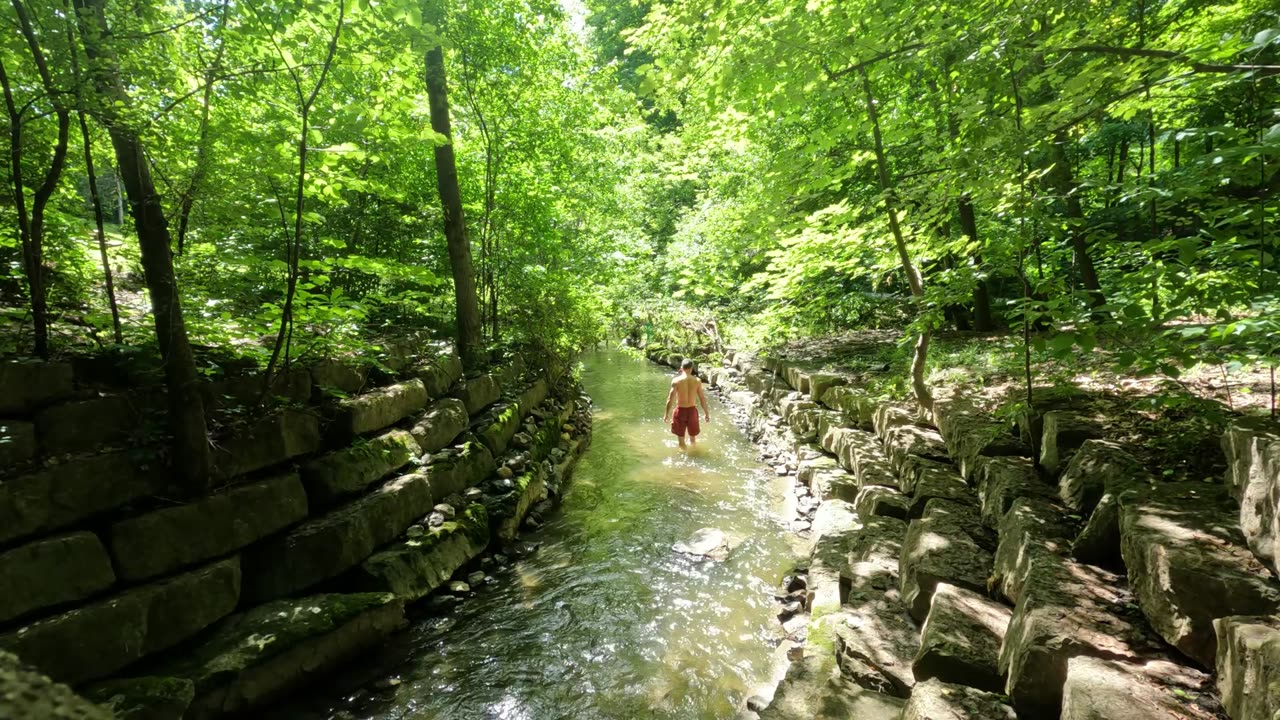Premium Only Content

☀️ In My Retirement 🌊 Day 10 Creek Life 🌴
🌞Healthy4Life - Creek Project 101 🌍 Natural Healthy Clay 🧱
Watch The series Day 1, 2, 3, 4, 5, 6, 7, 8, 9 below if you haven't seen yet.
Cleaned out all the glass and garbage on the bottom phase 1
removing all the dead wood and leaves phase2
moving rocks out of the creek to keep the current flowing phase 3
removing dead tress and bushes to open up creek access phase 4
adding a layer of rocks to the side phase 5
The objective of cleaning is not just to clean, but to feel happiness living within that environment.
sun, fresh air, water, nature = priceless
HealthySkin4Life - Clay Product
healthy ecosystem 101
Benefits of clay
Absorbing excess oil and sebum from the skin, preventing acne and clogged pores
Cleansing and detoxing the skin from dirt, dust, and pollution
Providing gentle exfoliation and enhancing blood circulation to brighten the skin
Hydrating and restoring the skin's balance
Relaxing and soothing the skin
Researchers believe bentonite clay adsorbs materialsTrusted Source by sticking to their molecules or ions. As the clay leaves the body, it takes the toxin or other molecules.
Clay detox is a natural remedy that has been used for centuries to remove toxins and impurities from the body1. Benefits of clay detox
Improving skin health
Treating digestive issues #NaturalClay
Boosting the immune system
Absorbing free radicals and toxins
Fighting infections
Helping you lose weight
Relieving allergies
When someone uses it on the skin, bentonite clay may have the power to adsorb oils and bacteria. When someone consumes the clay, it may adsorb toxins or other unwanted substances from the digestive tract.
Bentonite clay contains natural minerals such as calcium, magnesium, and iron, which may provide additional benefits.
Bentonite clay forms from volcanic ash. It gets its name from Fort Benton in Wyoming, where it occurs in large amounts.
People can also find this clay in other places where volcanic ash has settled into the ground. Montmorillonite clay, named after Montmorillon in France, is the same type of clay.
The following list looks at the potential benefits of bentonite clay and what the research says.
1. Removing toxins from the body
Various studies have examined bentonite clay’s effect on toxins in different models.
A 2019 studyTrusted Source highlights bentonite clay’s effectiveness at aflatoxin sorption in earlier animal and human trials.
The researchers also tested a sodium bentonite clay on computational, in vivo, and in vitro models, suggesting it may offer a method to combat emergencies, such as an outbreak of acute aflatoxicosis.
A 2022 case study Trusted Source used a combination of bentonite clay, probiotics, and black seed oil to treat a 2 year old with a Clostridium difficile (C. diff) infection. After four days, there were no traces of C. diff in the child’s stool samples.
According to a 2020 reviewTrusted Source, bentonite’s success as a detoxifying agent may stem from its structure.
However, a 2022 study Trusted Source suggests that the effectiveness of clays, including bentonite, to bind to various toxins in animal feed may depend on the type of toxin.
Despite this research, further studies on human models are necessary to further understand the extent of bentonite clay’s ability to remove toxins from the body.
How to use
People should not consume bentonite clay without speaking with a healthcare professional first. Healthcare professionals will be able to recommend the correct dosage and frequency of consuming bentonite to rid the body of toxins.
A doctor can ensure that someone uses safe types and amounts or can suggest alternative treatment options.
2. Treating oily skin and acne
Bentonite clay’s adsorbent power may help treat acne breakouts and oily skin. The clay may help remove sebum, or oil, from the skin’s surface, and it may have a calming effect on inflamed breakouts.
A clay face mask may help remove impurities from the skin to reduce the risk of pimples and skin infections.
However, further studies are necessary to prove the benefits of bentonite as an acne treatment.
How to use
Some commercial facial masks contain clays because of their clarifying effect on the skin. Some skin care masks contain bentonite, but people can also make a bentonite mask at home.
Mix bentonite clay powder with water to make a thick paste. Apply to the areas of skin that are prone to oil or acne. Leave the mask on for 20 minutes and rinse thoroughly. Repeat two or three times per week.
3. Detoxifying the skin
Some people use bentonite clay to cleanse specific parts of their body, including the following areas:
feet
face
4. Treating poison ivy
Many peopleTrusted Source are allergic to urushiol, the oil that poison ivy plants produce. When their skin comes into contact with poison ivy, they may develop the characteristic rash as an allergic reaction.
A poison ivy rash can cause redness, irritation, and severe itching. Bentonite clay may be an effective treatment option after exposure to poison ivy.
How to use
Wash the skin with soap and water as soon as possible after touching poison ivy. Use dish soap or a soap able to remove oils to help remove the urushiol from the skin.
Mix bentonite clay with water to form a paste and apply it to the affected area. Cover with a clean bandage or gauze pad. Repeat several times per day until the rash is gone.
-
 LIVE
LIVE
TimcastIRL
1 hour agoDemocrat Senator FORCIBLY REMOVED From DHS Presser, MAGA Says IT WAS STAGED | Timcast IRL
30,246 watching -
 LIVE
LIVE
Barry Cunningham
2 hours agoDID YOU GET YOUR TICKETS FOR THE DEMOCRAT CLOWN SHOW!!
7,203 watching -
 LIVE
LIVE
SpartakusLIVE
3 hours agoAre they really going to end WZ?? || Duos w/ @GloryJean
211 watching -
 8:04
8:04
MattMorseTV
6 hours ago $0.21 earnedTrump just DROPPED a BOMBSHELL on California.
4449 -
 46:10
46:10
Friday Beers
6 hours agoSkeletons, Cults, & Ex-Girlfriends Terrorize Our DND Campaign
24 -
 LIVE
LIVE
megimu32
1 hour agoON THE SUBJECT: STOP REMAKING CLASSICS — Hollywood Is Out of Ideas!
269 watching -
 LIVE
LIVE
MyronGainesX
16 hours ago $8.49 earnedIsrael Strikes Iran! WAR is here! ICE Riots, Diddy Trial And More!
4,053 watching -
 LIVE
LIVE
Spartan
3 hours agoPro Halo Player | Halo Infinite Ranked Arena into SWTOR
82 watching -
 LIVE
LIVE
Mally_Mouse
1 hour agoLet's Play!! -- 60 Seconds! -- I'm nervous..
90 watching -
 1:28:23
1:28:23
Glenn Greenwald
5 hours agoIsrael/Iran Escalation: WW3 or Negotiating Tactic? Plus: Analyst Curt Mills on Trump's Israel/Iran Policy and More | SYSTEM UPDATE #467
50K43